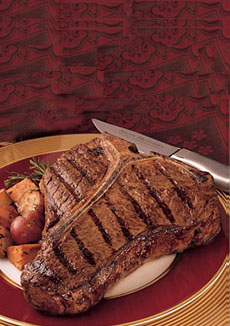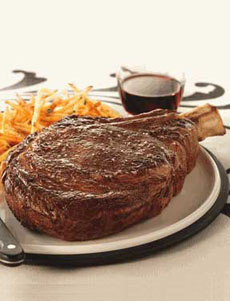TIP OF THE DAY: How To Choose Your Steak
 Rib eye or ribeye: the best combination of beefiness and tenderness. Photo courtesy Allen Brothers, a NIBBLE Top Pick Of The Week. |
Some people have a “signature steak.” At a steakhouse, our brother always chooses filet mignon; his friend Robert always orders the porterhouse; When we recently ordered a hanger steak, our brother taste it an declared it too chewy.
Chewy, juicy, flavorful: What’s your preference? We asked Chef Arturo McLeod of Benjamin Steakhouse in New York City and White Plains New York—someone who has perhaps eaten as much steak as anyone—for an expert point of view. His immediate preference: “Porterhouse steak, for sure. Comprising both the strip sirloin and the filet mignon, the Porterhouse is the ‘King of the T-Bones‘— the best of both worlds. Benjamin Steakhouse offers six cuts of dry-aged beef, from 36-ounce porterhouses to top sirloins to juicy and tender rib eyes to succulent filet mignon. This is part one of a two-part article. Tomorrow: how to buy and cook the best steak. WHICH CUT IS RIGHT FOR YOU? In alphabetical order, we present the chef’s choices: the four most popular steakhouse cuts: |
|
|
Filet Mignon Of all the prime cuts, filet mignon has the least marbling. This means that it is leaner and does not have as much flavor as the other cuts. But is also incredibly tender, with almost a buttery texture. Because this cut is so thick, it also takes the longest to prepare, especially when ordered medium-well to well-done. (Editor’s Note: Well done filet mignon? Say it isn’t so!) Porterhouse The most popular cut at Benjamin Steakhouse, the porterhouse includes the filet and the sirloin, with the T-bone in the middle (it’s also called a T-bone steak). The Porterhouse is best served simply, grilled with just a dusting of kosher salt. The largest cut, it can be divided among two, three, or four people—or one extremely hungry carnivore. Porterhouse is the ideal meat for grilling because the center bone conducts heat in the middle of the meat. This enables the steak to cook more evenly and prevents the meat from drying out and shrinking during cooking. For people who don’t like to struggle with the bone: At Benjamin Steakhouse, the porterhouse is served pre-sliced and presented on a piping hot platter, so that it literally sizzles as it is being served. |
||
|
Rib Eye
Of all the cuts on the menu, the rib eye steak has the most marbling, which means it is fattier but also has the most flavor. It is this marbling that makes the rib eye the richest and beefiest cut. At Benjamin Steakhouse, it is also served on the bone. Sirloin Sirloin has medium marbling, so it still delivers a nice, juicy flavor. The flavor is not as robust as the rib eye, but it is much easier to trim. There are no large pockets of fat, making it an easy-to-cook, easy-to-eat cut. Benjamin’s serves the sirloin on the bone, which helps it to cook more evenly. Chefs and customers alike agree that any steak cooked on bone—even though it’s on the side, not in the center as with porterhouse—produces a more flavorful piece of meat. |
|
|
|
Check out the many other cuts of beef in our Beef Glossary. IS AGED STEAK WORTH THE EXTRA MONEY? The best steakhouses use only USDA prime beef, carefully dry-aged in specially built aging boxes. The beef is chilled to a precise temperature and humidity level, for a minimum of 28 days. The dry-aging process enhances the flavor of the steak over time, as moisture evaporates from within the beef. It also tenderizes the beef by allowing the tissues to break down. This is a time-consuming, and therefore expensive, undertaking, but for a good reason: The key effect of the dry aging process is the concentration of flavor. Dry aged beef needs to be seasoned only with kosher salt, to allow the well developed flavors of the steak to shine.
|
||



